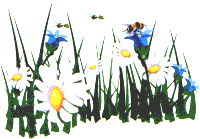The Dynamics of
Pollination
 Most of us are aware of the importance of pollination in
order for plants to be able to reproduce, and we are also quite aware of
how bees serve man by pollinating his fruit trees and vegetable crops.
In many places, however, bees have a hard time surviving or meeting the
needs of the plants that need pollination. Botanists have discovered
that pollinators that fly--like bats--can supplement bees. They have
also discovered 59 species of non-flying mammals that pollinate. In
many cases, the plants seem to be engineered to work with certain
mammals to pollinate the plants.
Most of us are aware of the importance of pollination in
order for plants to be able to reproduce, and we are also quite aware of
how bees serve man by pollinating his fruit trees and vegetable crops.
In many places, however, bees have a hard time surviving or meeting the
needs of the plants that need pollination. Botanists have discovered
that pollinators that fly--like bats--can supplement bees. They have
also discovered 59 species of non-flying mammals that pollinate. In
many cases, the plants seem to be engineered to work with certain
mammals to pollinate the plants.
 In Africa in a dry
area, there is a lily named Massonia
depressa. This plant forms two huge flat leaves like water
lilies seen in America. These leaves lie flat on the ground, and its
flowers sit on the ground in the same area. Starting each evening, the
plants secrete gobs of nectar as thick as jelly. These gobs attract the
hairy-footed and short tailed gerbils which get covered with pollen as
they open the flowers with their front legs and push their faces in.
Apparently these rodents are the prime pollinators, because when
researchers covered the flowers with mesh that would let insects in but
not the gerbils, the plants produced virtually no seed.
In Africa in a dry
area, there is a lily named Massonia
depressa. This plant forms two huge flat leaves like water
lilies seen in America. These leaves lie flat on the ground, and its
flowers sit on the ground in the same area. Starting each evening, the
plants secrete gobs of nectar as thick as jelly. These gobs attract the
hairy-footed and short tailed gerbils which get covered with pollen as
they open the flowers with their front legs and push their faces in.
Apparently these rodents are the prime pollinators, because when
researchers covered the flowers with mesh that would let insects in but
not the gerbils, the plants produced virtually no seed.
The advantages of diversity are seen in all kinds of human
endeavors, but it is also obvious that in nature a variety of different
systems have been designed so that one part of an ecosystem being
damaged or destroyed does not obliterate the whole ecosystem. The
dynamics of pollination show that in a beautiful way.
--Reference: Science News, Vol. 160, October 13,
2001, page 229.
Back to Contents Does God Exist?,
JulAug03.
 In Africa in a dry
area, there is a lily named Massonia
depressa. This plant forms two huge flat leaves like water
lilies seen in America. These leaves lie flat on the ground, and its
flowers sit on the ground in the same area. Starting each evening, the
plants secrete gobs of nectar as thick as jelly. These gobs attract the
hairy-footed and short tailed gerbils which get covered with pollen as
they open the flowers with their front legs and push their faces in.
Apparently these rodents are the prime pollinators, because when
researchers covered the flowers with mesh that would let insects in but
not the gerbils, the plants produced virtually no seed.
In Africa in a dry
area, there is a lily named Massonia
depressa. This plant forms two huge flat leaves like water
lilies seen in America. These leaves lie flat on the ground, and its
flowers sit on the ground in the same area. Starting each evening, the
plants secrete gobs of nectar as thick as jelly. These gobs attract the
hairy-footed and short tailed gerbils which get covered with pollen as
they open the flowers with their front legs and push their faces in.
Apparently these rodents are the prime pollinators, because when
researchers covered the flowers with mesh that would let insects in but
not the gerbils, the plants produced virtually no seed.  Most of us are aware of the importance of pollination in
order for plants to be able to reproduce, and we are also quite aware of
how bees serve man by pollinating his fruit trees and vegetable crops.
In many places, however, bees have a hard time surviving or meeting the
needs of the plants that need pollination. Botanists have discovered
that pollinators that fly--like bats--can supplement bees. They have
also discovered 59 species of non-flying mammals that pollinate. In
many cases, the plants seem to be engineered to work with certain
mammals to pollinate the plants.
Most of us are aware of the importance of pollination in
order for plants to be able to reproduce, and we are also quite aware of
how bees serve man by pollinating his fruit trees and vegetable crops.
In many places, however, bees have a hard time surviving or meeting the
needs of the plants that need pollination. Botanists have discovered
that pollinators that fly--like bats--can supplement bees. They have
also discovered 59 species of non-flying mammals that pollinate. In
many cases, the plants seem to be engineered to work with certain
mammals to pollinate the plants.